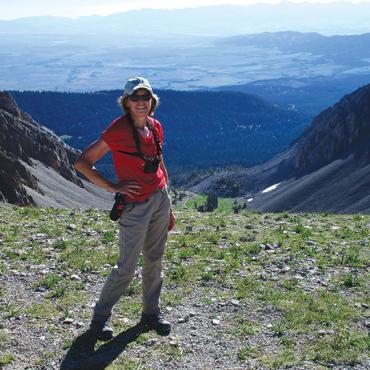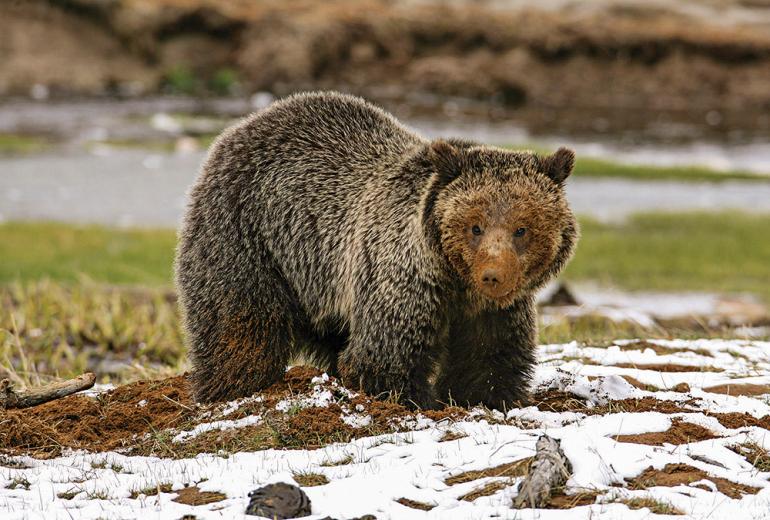A League of Their Own
The unique character of Greater Yellowstone grizzlies.
Hiking along a trail in the Absarokas, Louisa Willcox all but stumbled into a grizzly bear. She likens it to a Keystone Cops moment: braking just before she collided with the bear, falling backward on her butt, the student behind her bumping off the back of Louisa’s towering pack.
As a mountaineering instructor for the National Outdoor Leadership School (NOLS), Louisa was leading a group into the wilderness. She and the students watched in stunned silence as the grizzly spun on its heels, splashed through the creek, and crashed away into the forest.
That was back in 1974, but you can still hear the awe in Louisa’s voice when she recalls her near-collision with the animal she now steadfastly advocates for and defends. Her career working for various conservation groups, including the Natural Resources Defense Council and Greater Yellowstone Coalition, revolved around preservation of wilderness and wildlife, especially grizzlies. She became a driving force of grizzly conservation and recovery, strategizing through grassroots organizing and outreach, lobbying, education, coalition development, and policy analysis. Intent on reducing mortalities through the lens of conservation, Louisa has been examining patterns and trends behind human-caused grizzly deaths, as well as success stories of coexistence and habitat protection. She was also a pivotal figure behind the recent listing of the whitebark pine, a vital grizzly food source.
Her husband, Dr. David Mattson, has been promoting restoration of grizzlies in central Idaho. He also focuses on ensuring that government agencies “produce relevant science to help foster better public understanding of grizzly bears, and to support better decision-making outcomes.” David holds a 35-year career as a wildlife researcher studying grizzlies and mountain lions, including 15 years of intensive field studies in which he helped document unique behaviors among the estimated 150 grizzlies living in and around Yellowstone National Park.
Some of these behaviors, although unique now, likely occurred within other grizzly populations in North America prior to their widespread extirpation, leaving only a few isolated areas that they currently occupy. Conservatively, around 700 grizzlies inhabit the Greater Yellowstone Ecosystem (GYE), an area of 12-22 million acres, depending on where you draw the line, including Yellowstone National Park.
Grizzlies are smart, curious omnivores who spend most of their time feeding, especially during hyperphagia—the time leading up to hibernation. For a mind-blowing account of what happens to a bear’s body during hibernation, check out Louisa’s “Bear Dreaming: of Wonder in Winter” on her blog, Grizzly Times. Louisa and David co-founded Grizzly Times—a website featuring updates and commentary on news, policy, and science—to provide relevant information on grizzly-bear conservation to the public.
Yellowstone-area grizzlies awaken from hibernation and can appear on the landscape as early as February or as late as May. Like all bears, despite not eating or drinking for up to six months and losing up to 30% of their body weight, they emerge with muscle and bone mass intact, on the hunt for food.
That’s where things take an interesting turn with Yellowstone-area grizzlies.
Partly due to their unique environment, Yellowstone-area grizzlies enjoy some dining choices not shared by their ursine counterparts elsewhere. The term is “geophagia”—a fancy name for eating dirt. But not just any dirt. Yellowstone-area grizzlies eat dirt from geothermal areas—and not just any geothermal areas. Exhibiting behavior documented nowhere else in North America, or in fact, the world, Yellowstone-area grizzlies excavate and consume soil from specific thermal areas containing high levels of potassium and sulfur. As this is only an early-spring behavior; researchers believe that the bears are instinctively replacing potassium lost during hibernation, as well as stimulating their long-dormant digestive tracts with sulfur.
Grizzlies are generalist omnivores, meaning, there’s a lot on the menu. A typical spring meal might include dandelions, grasses and sedges, carrion, or the occasional elk calf. Spring is also pocket-gopher season for Yellowstone-area grizzlies, the only population that’s been documented digging up and eating the little critters, along with their root caches.
Biscuit root is another favored grizzly snack, and Yellowstone-area grizzlies seem especially fond of the small tuber, digging it up from April through July as they track the flowering plant from low to high elevations. While other bears typically graze on the foliage of sweet cicely, Yellowstone-area grizzlies also eat the roots. They’re the only grizzlies known to excavate yampa roots, found in moist meadows. In fall, they dig pondweed roots, mostly found in the bottoms of dried ponds within the Yellowstone caldera.
It takes a lot of gopher hors d’oeuvres and salad to satiate a 500-pound grizzly, and fishing for cutthroat trout helps round out a meal. Although less dramatic than the classic photos of spawning salmon launching themselves into the cavernous maws of coastal grizzlies, Yellowstone cutthroat run a similar gauntlet in tributaries around Yellowstone Lake. Unfortunately, competition with non-native lake trout has caused a dramatic decline in the native cutthroat population, but at one time, Yellowstone’s interior grizzlies consumed more of this high-quality food than any other interior population.
Unfortunately, whitebark pines are also in decline. Whitebark seeds are a high-fat delicacy sought by birds, squirrels, and bears, including grizzlies. A variety of environmental factors, including climate change, have substantially reduced yet another food source used more widely by Yellowstone-area grizzlies than other populations.
Yellowstone bears have also been documented digging up and eating earthworms, rooting around in lodgepole pine forests foraging for mushrooms (including false truffles), and in the Absaroka Range, climbing up to 10,000-foot-high boulder fields to scrounge for army cutworm moths. While not a unique behavior, grizzlies here consume moths in greater amounts than other populations—as many as 40,000 a day.
Then there’s bison.
Yellowstone National Park is the only place where grizzlies and bison still share an ecosystem. Bison are formidable beasts—large, aggressive, and downright cranky when their space is invaded during the rut. Males can tip the scales at 2,000 pounds, but are surprisingly agile, capable of jumping five feet high and cruising along at 35 miles per hour. Fiercely protective, they also engage in collective defense. As Dr. Mattson points out, grizzlies aren’t stupid, so they usually wait for bison to die natural deaths.
According to Kerry Gunther, the Park’s lead bear biologist, GYE grizzlies eat more meat than grizzly populations in other areas, including Glacier National Park, due to higher populations of ungulates. Mature elk, as well as their calves, are a primary food source for Yellowstone-area grizzlies. They also predate on bison calves late April through June. Although it’s uncommon for a grizzly to take down a full-grown bison, two cases were witnessed in the Park in 2020. Typically, grizzlies consume bison in the form of carrion in spring (winter kill), then again late summer from bison injured during rut.
Bison carcasses turn up on Yellowstone’s landscape for a variety of reasons. Disease, birthing mishaps, rutting injuries, and wolf packs all are known factors. Opportunistic grizzlies then scavenge (or steal) the prize, easily ripping through the thick hide, gorging on vital protein for days on end.
Springtime at Blacktail Ponds in Yellowstone, inevitably it seems, offers up the defrosted carcass of an unfortunate bison that fell through the ice over winter. As the pungent, waterlogged mass floats around in black goo, eagles and ravens do their best to pluck off tidbits, while wolves and coyotes risk falling victim themselves, straining to reach the distorted delicacy. Then, soon enough, a hungry grizzly arrives, beelining across the greening meadow, honing in on a scent that he may have detected from 15 miles away. Splashing into the muck, “fishing” with massive paws and four-inch claws, and using the power of its distinctive muscle known as the “hump,” the grizzly, seemingly effortlessly, slides the corpse closer to shore, gradually coaxing it up and onto the pond’s bank. Over the next week or so, as the bear feasts and sleeps on its prize, slowly reducing it to a pile of hide and bones, the omnipresent wildlife watchers and photographers vie for front-row seats to a drama that plays out only in Yellowstone National Park.
Although ideal grizzly country, habitat fragmentation and lack of tenable wildlife corridors sets Yellowstone-area grizzlies apart from other populations, challenging their genetic diversity and long-term viability.
Currently, all grizzlies in the Lower 48, including those living in Yellowstone National Park, are protected as Threatened under the Endangered Species Act. The political reality is that grizzlies are always in the crosshairs, caught between legislative attempts to remove their federal protections and proponents—like Louisa Wilcox and Dr. David Mattson—fighting for a day when grizzlies return to their true historic range.
Louisa’s “abiding love for the bear and a sense of responsibility to leave future generations a chance to catch a glimpse of the grizzly in the wild” keeps her fighting for Yellowstone-area grizzlies, a population that she and David consider to be “natural treasures,” exhibiting a living museum of behaviors lost everywhere else except for the special place they still call home.
A Judicious Berth
Yellowstone National Park is without a doubt one of the more spectacular tourism destinations in the American West. Its unique geothermal nature, beautiful and expansive landscapes, abundance of wildlife, and ease of accessibility provide a rare and unique glance into the wild. Yellowstone’s resident wolves, bears, bison, and elk are frequently seen thanks to some 200 miles of roads dissecting 2.2 million acres of relatively undeveloped wilderness.
This has made photographing elusive animals like wolves quite easy. So grab your camera, take a drive, and off you go toward a career with National Geographic, right? Wrong. Unfortunately, with prime accessibility comes human-caused issues like illegal feeding, vehicle strikes, and habituation, all of which are present in Yellowstone. Most common, though, is the inappropriate lengths visitors will go to for a photograph, whether it’s with a cellphone or a camouflaged telephoto. We have all seen the videos: bison tossing children, elk impaling cars, bears charging tourists, and even wolves carrying tripods. While we should take advantage of the Park’s access to viewing and photographing wild animals, do so responsibly. We see enough idiocy on a daily basis. In Yellowstone, treat the Park and its animals with respect to ensure that others can enjoy them tomorrow. —Kyle Dudgeon
On the Menu
Grizzlies in Yellowstone are the only bear population to still eat bison meat, a behavior that was once widespread wherever grizzlies and bison coexisted. Almost all of the meat from bison is obtained by scavenging. Bison are important to grizzlies because there is so much meat on them—enough to swamp most smaller scroungers, with hides thick enough to deter any other scavengers except for wolves. Most bison meat is obtained during the spring from winter-killed animals, but there is a secondary peak in consumption during August-September as grizzlies scavenge bull bison that died during or shortly after the rut. —David Mattson
Federal Fight
Due to grizzlies’ increased dependency on human food and garbage, as well as high rates of attack-related injuries and property damage, Yellowstone National Park introduced a thorough bear-management program in 1970. Federal and state agencies went further in 1975, when grizzly bears were listed as Threatened under the Endangered Species Act, banning a trophy hunting season, creating grizzly recovery areas, and forming agencies to monitor restoration progress. In 2017, the U.S. Fish and Wildlife Service declared grizzlies recovered, and many ESA protections were lifted. However, in 2019, they were relisted as a Threatened species, a status they retain today. Continued recovery acts have allowed the grizzly population in the Greater Yellowstone Ecosystem to increase from 136 bears in 1975, to 728 in 2019. —Naomi Ohman







